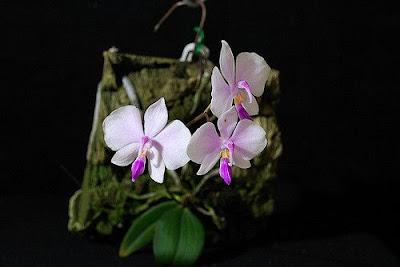Low's Phalaenopsis is native to Borneo and nearby Moulmein, Myanmar (Tenasserim mountains) in the delta of the Gyne, Salween and Ataran rivers, which are periodically flooded. Phalaenopsis lowii usually grows on bare limestone rocks with limestone rocks at elevations around sea level to 800 meters near rivers, where the morning sun fully reaches, but afternoons are shady. It also grows on twigs of small shrubs that are rooted in rock crevasses.
Phalaenopsis lowii, also called as Low's Phalaenopsis (named after the gardener and collector Low), Doritis lowii, Phalaenopsis lowii f. alba, Phalaenopsis proboscidioides, Polychilos lowii, is a species of the genus Phalaenopsis. This species was described by Heinrich Gustav Reichenbach in 1862.
IDENTIFY PHALAENOPSIS LOWII ORCHID
Low's Phalaenopsis is native to Borneo and nearby Moulmein, Myanmar (Tenasserim mountains) in the delta of the Gyne, Salween and Ataran rivers, which are periodically flooded. Phalaenopsis lowii usually grows on bare limestone rocks with limestone rocks at elevations around sea level to 800 meters near rivers, where the morning sun fully reaches, but afternoons are shady. It also grows on twigs of small shrubs that are rooted in rock crevasses.
It is a hot to warm growing, miniature epiphyte or sometimes lithophyte with deciduous leaves, with an erect or ascending stem enveloped by imbricating leaf bases carrying elliptic, obovate or oblong-elliptic, fleshy, acute or obtuse leaves. The leaves are 5-10 cm long, bright green with purple spots on the underside.
Phalaenopsis lowii blooms in the summer and fall on a lateral, arcuate to pendant, 10 to 15" (25 to 37.5 cm) long, racemose or rarely paniculate, laxly many flowered inflorescence with small triangular bracts and fragrant, fleshy, long-lived flowers that have an extremely long, beak-like rostellum. The flowers are 4-5 cm in diameter. They are magnificent, with a star shape and a delicate texture. The outer whorls and the broad petals of the inner whorl are white with a pink to purple tinge at the base. The lip is deep purple and has yellow spots.
GROW AND CARE PHALAENOPSIS LOWII ORCHID
Cultural information should only be used as a guide, and should be to be adapted to suit you. Your physical location; where you grow your plants, how much time you have to devote to their care, and many other factors, will need to be taken into account. Only then can you decide on the cultural methods that best suit you and your plants.
Light:
Phalaenopsis lowii needs a light level of 10000-15000 lux. A shaded position in the afternoon is recommended.
Temperature:
It is a thermophilic plant. In summer, the average day temperature is 28-32 ° C, night 24 ° C, which gives a small daily difference of 4-7 ° C. The average winter day temperatures are 31-35 ° C and the average night temperatures are 19-23 ° C, with a daily amplitude of 10-13 ° C.
Humidity:
This plant needs the humidity level of 80% or more during active growth. The highest temperatures often corresponding to the lowest humidity levels.
Substrate, growing media and repotting:
This species ca grow in pot with 12-16 mm pieces of fir or pine bark as substrate. Repotting is best done in spring, when fibrous roots begin to actively grow.
Watering:
Low's Phalaenopsis needs water about once a week. Keep plant fairly moist but not wet. Air movement and perfect drainage are particularly important.
Fertilizer:
In the period of active growth, it is recommended to apply once a week or once every two weeks 1/4-1/2 of the recommended dose of fertilizer for orchids.
Rest period:
In a natural habitat, there is a 3-4 months period of a cold, dry resting period with periodic low rainfall, while usually one month of rest is sufficient and should not exceed two months. During the rest period humidity should be reduced to 60-65%, watering should be limited to occasional fogging, stop fertilization and increase the level of light. Although it can survive long, dry dormancy, in such conditions the leaves may fall, which is not desirable in cultivation. Plants are in better condition and easier to bloom when 3-5 leaves remain on the plant.















COMMENTS